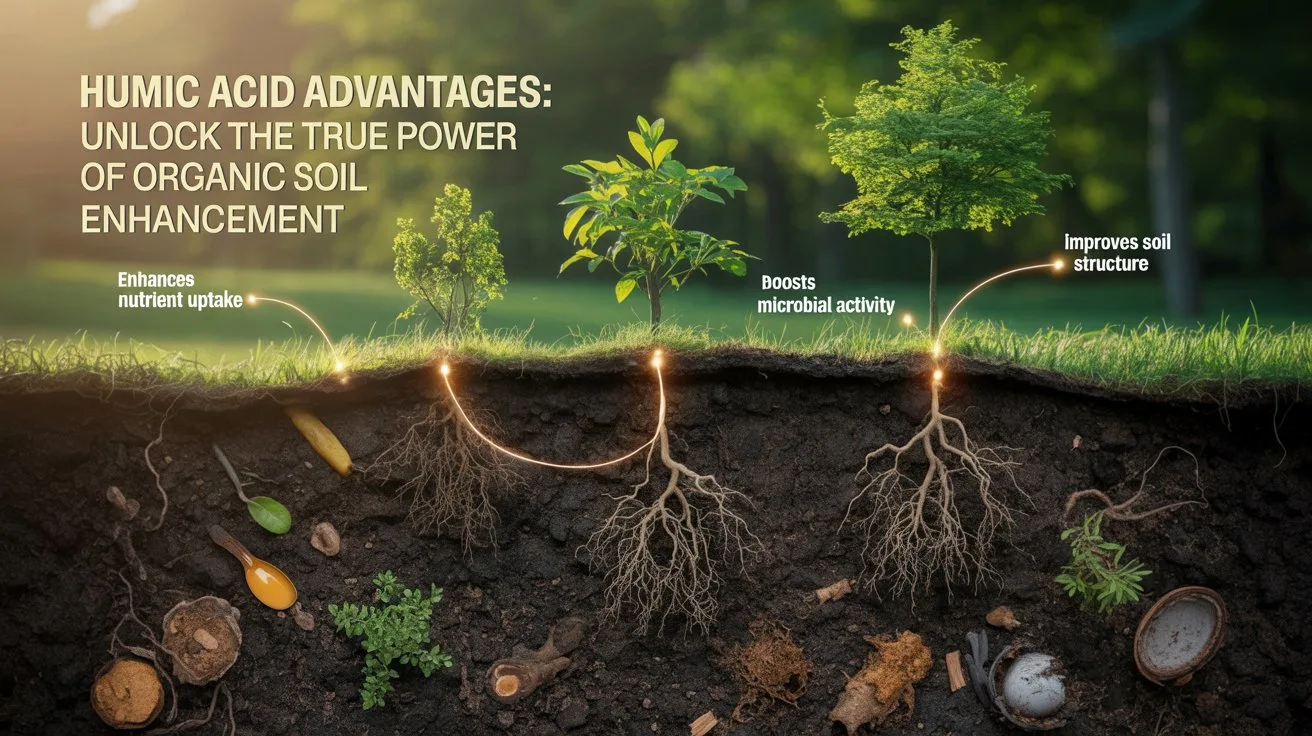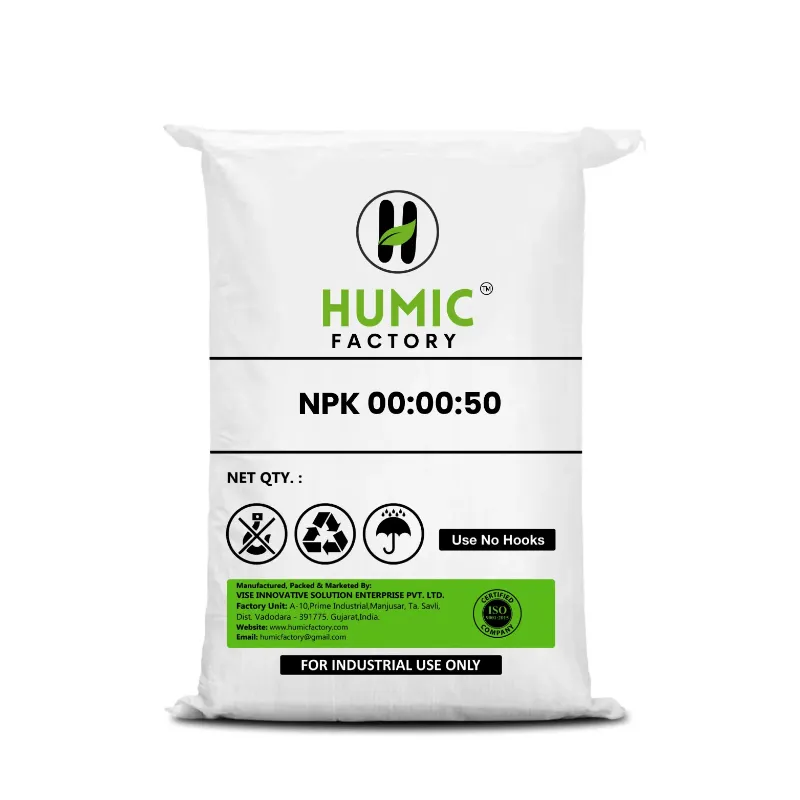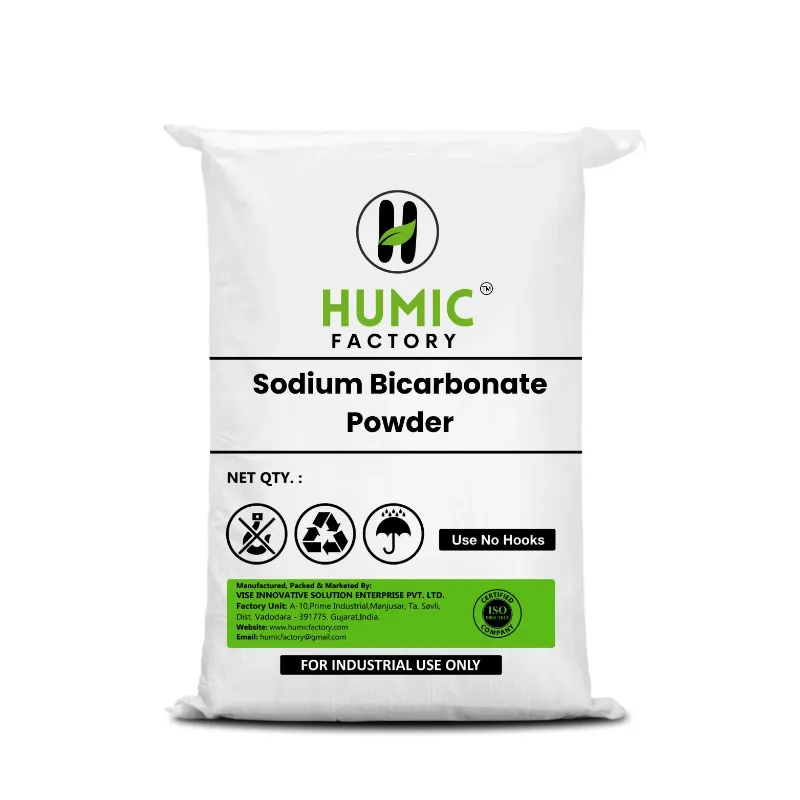Humic acid is a natural, organic soil enhancer that has been used for ages by farmers and gardeners.
It contains lots of carbon, minerals, and bioactive compounds that can improve soil quality, promote root growth, and help plants absorb nutrients.
The benefits of humic acid can improve soil structure, improve yields, and lower your reliance on chemicals.
When you need a humic acid fertilizer for crops or humic acid liquid fertilizer for your home garden, humic acid has a formulation for almost every purpose.
If you are looking for a clean, sustainable way to build long-term soil health naturally, organic humic acid is the best for you.
Whether it's one thousand acres of wheat or one thousand square feet of tomatoes. One drop of humic acids is life to your land.
Introduction – What Is Humic Acid and Why It Matters in Agriculture
Humic acid is a natural organic matter caused by the slow decomposition of plants and animals and is found in soil.
It's not a fertilizer, in the common sense - but rather a powerful soil conditioner that can improve soil structure, water holding capacity, and availability of nutrients.
Why it matters:
In modern farming, soil programs are often declining in health due to chemical over use, and the use of humic fertilizer can be a sustainable, nature-based way to rejuvenate fields and improved plant performance.
Understanding Humic Acid and Its Natural Formation
It is derived from decayed material (usually from compost, peat or the depositions of highly decomposed organic matter called leonardite, which took thousands of years to form).
How it is formed:
Microbes breakdown pieces of plant material over time to release a dark, nutrient-rich substance called humic acid.
Forms available for sale:
You will find it granular, powder, or if you are using liquid humic acid as a liquid fertilizer, depending on the application method.
Key Humic Acid Benefits in Soil and Plant Systems
The benefits of humic acid go way past nutrient fertilization and can do many things for your farm or gardening, including:
- Increases nutrient acquisition: Helps roots acquire more nitrogen, phosphorus and potassium.
- Improves soil structure: Breaks up compacted clay and aggregates sandy soils to create the best conditions for roots.
- Increases water retention: Very important if you are in a drought or dry area.
- Supports plant growth: Improves germination ability, root strength and increases overall crop yields.
- Feeds the microbes: Supports beneficial soil life that helps plants grow naturally.
All together these benefits make humic acid fertilizer an important part of intelligent farming or gardening.
Role of Organic Humic Acid in Modern Farming
With increasing demand for clean and chemical-free foods most farmers are opting for organic humic acid products. You can be sure it is safe for the environment, it will enhance soil fertility in the long term and is compliant with certified organic farming practices.
- Compatible with other organic inputs:Uses well with compost, manure and bio-fertilizers - and is thus a compatible operator within any programme involving natural farming.
- Flexible in both small- and large-scale agriculture:From vegetable beds to tree crops or rice paddies, humic acid liquid fertilizer can be applied as a foliar spray, by drip irrigation or as seed treatment.
Humic Acid Fertilizer and Its Impact on Soil Fertility
Humic acid fertilizer is important to help improve and restore soil fertility in conventional and organic agricultural systems.
Although humic acid does not supply major nutrients such as NPK, it is a biological stimulant to enable nutrients to be more available, contributes to improving soil conditions and provides long-term, productive capacity.
Of the numerous humic acid benefits, its ability to rejuvenate tired or depleted soils is of particular importance, making humic acid an effective amendment in sustainable agricultural practices for cropping.
How Humic Acid Fertilizer Improves Soil Texture and Structure
One of the main advantages of humic acid fertilizer is its effect on textural and structural aspects of soils.
- It binds together the loose particles in sandy soils to retain water and lessen the risk of erosion.
- In soils with clay, it loosens up clay compact layers, allowing for aeration and drainage.
The resulting environment favors root expansion and promotes microbial activity, which fosters overall plant health.
Better soil structure also leads to better tilth, easier cultivation activities, and stability of the root systems.
Enhanced Nutrient Retention and Availability in Crops
Another significant benefit of humic acid is its capacity to retain and release nutrients efficiently.
- Humic acid is a chelator. It bonds to minerals like calcium, magnesium, iron and allows them to remain soluble and plant-available longer.
- Humic also decreases nutrient leaching, especially in sandy or low organic matter soils.
This means crops can take up more of the fertilizers applied, whether it be synthetic or organic and you can maximize the use of every input.
Humic acid liquid fertiliser is a great way to reap all of these benefits in the shortest amount of time by using foliar or drip application systems.
Boosting Organic Matter and Microbial Life in Soil
The long term health of our soil relies on organic matter, and microbial activity in the soil ecosystem.
- Organic humic acid stimulates beneficial microbes to begin consumer feeding on organic residues and in the process, releases the plant nutrients contained in the organic residues.
- It promotes nutrient cycling, reduces soil borne disease, and enhances the soil food web.
Regular addition of humic acid fertilizer allows a healthy and robust underground ecosystem to develop, resulting in fertile, resilient, and biologically active soils.
This is certainly one of the most significant humic acid benefits for farmers seeking to lessen their reliance on chemical use and to adopt more sustainable practices.
Humic Acid Advantages for Plant Growth and Yield
One of the most significant reasons why farmers and gardeners use humic acid fertilizer is its beneficial effect on plant growth and yield.
Humic acid fertilizer differs from traditional fertilizers in that traditional fertilizers only “feed” the plant while humic acid will positively affect plants at the root and soil level—helping to improve conditions which promote sustained, healthy growth. This creates stronger plants, increased productivity, and better nutrient utilization, which is important over time.
The following points cover the key humic acid benefits for the health and output of plants.
Better Root Development and Water Retention
Humic acid enhances root growth by improving the structure of soil, and increasing the availability of root-accessable nutrients.
- A humic-rich soil will provide roots with deeper and denser growth by accessing more water and nutrients.
- In a drought situation, organic humic acid will help keep moisture contained in the root zone, reducing drought stress.
The benefits of humic acid will allow plants to grow well and thrive under difficult environmental conditions. This means the plants will show better resiliency and be more productive throughout the grow cycle.
Improved Nutrient Absorption and Photosynthesis
One of the key humic acid benefits is to improve nutrient uptake.
- It increases the permeability of root cell membranes so that essential elements (nitrogen, phosphorus, and potassium) can be absorbed more easily.
- As nutrition is improved, the plant will improve the photosynthesis process better, allowing stronger vegeative growth and energy production.
By incorporating humic acid fertilizer on a crop routine or practice, farmers can increase the benefit from every input applied to the plants. This is evident in the healthier appearance of the plants, and less reliance on excessive chemical fertilizers.
Stronger, Healthier Crops with Higher Yields
Healthier roots and improved nutrient uptake will naturally result in stronger, more productive plants.
- Crops treated with humic acid liquid fertilizer will tend to produce crops with greater chlorophyll content, improved flowering, and more even development in fruits or grains.
- Plants also seem to have improved immune responses to pests, drought, or environmental stresses.
The outcome is merely greater yields with better quality - whether that is more fruit, bigger grains, or stronger stem.
For commercial farmers, and organic growers, producing these outcomes makes using humic acid fertilizers a beneficial and cost-effective component of their fertility strategy.
Disease and Stress Resistance Through Organic Humic Acid
Along with enhancing soil fertility and plant growth, organic humic acid helps strengthen plants coping with disease and environmental stress. Humic acid does more than contribute nutrition—it promotes the overall immunity and strength of crops.
The benefits of humic acid could not come at a better time for agriculture, with unpredictable weather conditions and other soil-related issues affecting crop productivity. Too often, the best agricultural practices are not even enough to meet minimum crop expectations. Incorporating a quality humic acid organic fertilizer into a normal growing regimen can produce healthier, stronger crops.
Natural Protection Against Soil-Borne Diseases
Soil-borne diseases are one of the longest-lasting threats to plant health. Soil-borne diseases generally occur when soils are low in nutrients or have low aerobic levels, and adding a humic acid fertilizer improves the overall structure and oxygen availability within the soil, as well as the balance of soil microorganisms.
- Humic acid fertilizers encourage the growth of beneficial microbes that can naturally suppress the growth of harmful pathogens.
- Plants supported with humic acid grow healthier roots which are less susceptible to becoming infected or experiencing rot.
When a plant has some form of natural disease resistance it means that the fungicidal chemical treatments will be reduced and that there will be a balanced protective environment underground that keeps the crop safe from the beginning.
Reducing Plant Stress from Drought and Salinity
A further significant humic acid benefit is that it can help plants withstand abiotic stress, including drought and high salinity.
- Organic humic acid increases soil water-holding capacity, providing more of a buffer for the plants in times of low water availability.
- In saline soils, it helps to facilitate balance of ion exchange and reduce the toxic effect of excessive salt on plant roots.
The end result is more consistent growth under difficult environmental conditions. Many farmers using humic acid liquid fertilizer noted that they had improved crop potential in hot summers and inconsistent irrigation conditions.
Boosting Immunity and Resilience in Crops
When utilized repeatedly humic acid fertilizer build internal robustness in the plant.
- It enhances metabolic functions and antioxidant production, and the plant's own internal resistance.
- Crops will react positively with stress, temperature changes, transplant stress or pest attack.
The enhancement of the plants vigor and resilience will be especially useful for long duration crops or high value vegetables - where any level of stress can reduce yields.
Using humic acid liquid fertilizers in the early growth stages means they have the best chance of maturity while coping with environmental stress over their lifespan.
Sustainability Benefits of Humic Acid Liquid Fertilizer
Modern agriculture is faced with increasing pressure to produce more food while incurring less environmental cost. In this context, humic acid liquid fertilizer has numerous sustainability contributions that align with the objectives of environmentally friendly and regenerative farming. Humic acid is additionally a means of lessening chemical inputs while enhancing soil health and enabling precision farming.
The following items explain the key humic acid impacts which contribute to long-term environmental and economic sustainability.
Reducing Dependency on Chemical Fertilizers
In many farming systems now, reliance on synthetic fertilizers has compromised soil health. Humic acid fertilizer can provide a natural alternative or supplement to lessen reliance on synthetic fertilizers without compromising productivity.
- Humic acid fertilizer can increase the effectiveness of fertilized nutrients by enhancing nutrient availability and retention at the root-zone.
- With improved nutrient use efficiency, farmers can reduce the amount of NPK they apply, while maintaining an equivalent or greater yield.
Reducing the amount of unnecessary synthetic fertilizers not only increases yield and profit for farmers, it also decreases chemical inputs that may runoff into adjacent waters returning chemical nutrients back into the environment.
Supporting Eco-Friendly and Regenerative Agriculture
Organic humic acid is paramount for regenerative farming which aims to restore soil health, combat water loss and restore biodiversity.
- It chelates nutrients, promotes organic carbon soil levels, and nourishes beneficial microbes in depleted soils.
- Arguably, unlike chemical fertilizers that degrade soil health over the long-term, each application of humic acid will improve and amend the soil.
In fact, for farmers that want organic certification or just implement greener practices, organic humic acid is a safe compliant product.
Why Liquid Humic Acid is Ideal for Precision Farming
Precision agriculture is all about precision, timing and efficiency; humic acid liquid fertilizer fits perfectly within this system, not only because of how it is rapidly uptake applied but due to the convenience with application.
- Humic acid liquid can be delivered directly through drip or soil application or on-foliar on a plant, allowing nutrients to be delivered directly to the active root zone or through the leaf.
- Because humic acid is delivered in liquid form, it distributes evenly throughout affected areas, lending itself extremely well to automated irrigation systems and GPS-controlled application technologies.
This is one of the most advantageous humic acid benefits, to large scale farms and high-efficiency operations - it is one product that allows for better resource utilization with measurable impact.
Economic Humic Acid Advantages for Farmers
For today's farmers, profit is directly tied to how efficiently they use inputs and the longevity of soil productivity. Humic acid fertilizer can do both. As a natural conditioning material, it will help you reduce your input costs while simultaneously improving plant performance, which makes it an excellent addition in any cost-effective cropping system.
Let's examine the economic benefits of humic acid that represent an opportunity for both small- and large-scale farmers.
Cost-Effective Crop Management with Humic Acid Fertilizer
Most compelling is the way that humic acid fertilizer enhances plant health and soil conditions with fewer expensive chemical inputs.
- It increases the general uptake of nutrients so that you get almost double the value from the fertilizers you are applying.
- Since it is a natural soil conditioner, humic acid fertilizer eliminates the need for whole-sale inputs of synthetic soil amendments over multiple applications even through to harvest.
With repetition trying to identify the impact of chemical fertilizers and soil enhancers can add up to some considerable savings per acre down the road, particularly if you are utilizing organic humic acid as the soil conditioner for ecological agricultural systems.
Increased ROI Through Enhanced Fertilizer Efficiency
Another key economic benefit is using humic acid liquid fertilizer increases the efficiency of the user's existing fertilizer programs.
- Humic acid chelates nutrients and advances their availability to plant roots and therefore reduces waste and improves absorption.
- This ultimately translates into stronger root systems, healthier plants, and capabilities to achieve higher yields without increasing the volume of inputs.
Farmers report overall more uniform yields and yield quality when humic acid fertilizer is routinely applied during the plants' critical growth stages. It also means more ROI (return on investment) during each crop cycle, which is important in tight markets that are competitive as well as cost-sensitive.
Long-Term Benefits of Soil Investment with Organic Inputs
The soil is a living organism and investing in the long-term health of soil will be the basis of sustainable agriculture. One of the best actions you can take to improve the health of soil is to use organic humic acid and natural·exogenous products. Humic acid fertilizer differs from synthetic fertilizers, in that they will provide a quick burst but will not last long. Humic acid fertilizer is recognized for a long-lasting improvement in soil physical characteristics, nutrient retention, biological reaction over time.
These long-term humic acid benefits will produce healthier plants or crops, effective rejection to input dependence, and healthy soil year after year.
Choosing the Right Form – Granular vs. Humic Acid Liquid Fertilizer
Humic acid fertilizer comes in multiple forms, each with its advantages and applications. Farmers and gardeners should decide on the form of humic acid fertilizer to use based on their goals, type of crop, soil condition, and application systems available.
Both granular and humic acid liquid fertilizer will provide you with excellent results, but the forms differ in speed of transmission, ease of use, and how long the application will last.
When to Use Liquid Humic Acid for Quick Results
Humic acid liquid fertilizer is recommended for situations where speed of response or precision placement is required.
- Liquid humic acid is best for foliar spray or fertigation where nutrients can be applied via a drip irrigation system.
- Liquid will be absorbed quickly and delivered immediately to the root zone or plant foliage.
Liquid is primarily used early in the development of plants, when transplanting, or when crops are exhibiting signs of nutrient stress. It is especially effective in high value crops where there is significant value in every stage of growth.
Granular Humic Acid for Long-Term Soil Enrichment
Granular humic acid is a fantastic option for improving soil structure and organic matter slowly over a number of seasons.
- Granular humic acid can only be incorporated into soil during land preparation or as a top seed dressing.
- This form is an extremely slow release product which will, in effect, continuous feed beneficial microbes and improve the soil over time period.
One of the best features about granules is that it may be used in orchards, plantations, and any other situation where the end goal is to improve the soil for the long term. Granules are an effective tool for conventional and organic humic acid programs.
Application Tips for Organic Humic Acid in Different Systems
Successful use of organic humic acid relies on knowing your system/type, and timing it right.
- Liquid forms are best for routine feeding with drip irrigation systems.
- Granular forms are preferable for deep soil conditioning in rainfed or low-irrigation areas.
- If you are using it for a greenhouse or nurseries, both forms will give you immediate and residual responses.
Apply humic acid fertilizer when commercial crops are in their initial thinking or root development phase, before flowering, and again after a harvest for soil rebuilding. Always respect dosages and consider using humic acid in combination with compost or biofertilizer for synergistic effect.
Success Stories and Farmer Testimonials
Research indicates humic acid is effective, but it is hard to argue with results under real-world conditions. From different areas and different farms, growers are seeing quantifiable improvements in crop yield, soil health, and sustainability as a result of applying humic acid fertilizer. These stories illustrate the real-world humic acid benefits that are not purely theoretical and actually produce results in practice.
Crop Yield Improvements from Humic Acid Application
One of the most consistent pieces of feedback from farmers, who apply humic acid fertilizer, is the noticeable improvement in yield.
- In Maharashtra, a tomato farmer noticed a 20% improvement in fruit weight with better shelf-life after applying humic acid liquid fertilizer in their drip irrigation system during the flowering and fruiting stages.
- In Punjab, a wheat farmer had better grain filling and less lodging when granular humic acid was applied into the soil preparation just prior to sowing.
Again, this improvement was not due to an increase in chemical inputs, but rather due to better nutrient efficiency, and therefore healthier plant systems; distinct signs of humic acid benefits in action in normal farm conditions.
Case Studies of Transition to Organic Humic Acid
Many farmers wanting to minimize chemical use or transition to organically certified production, have adopted (in some cases, as part of their fertility program) organic humic acid.
- "An organic vegetable farm on a small scale farm in Karnataka replaced synthetic growth boosters with organic humus acids, with compost. After two seasons, the farm discussed evidence of better soil softening, fewer pest pressures and more consistency in crop quality.
- "A citrus grower in Gujarat said his orchard showed more flowering and less leaf drop after changing from conventional to an organic system with the addition of humic acid liquid fertilizer even during times of stress."
While these farms had successful economics, they also improved the circumstances for receiving organic certification decisions.
Sustainable Practices Adopted by Real Farmers
Besides yield, farmers are seeing the value in humic acid fertilizer, based on sustainability for their systems.
- In Rajasthan, where water management is important, farmers who use humic acid are noticing retention in their soils and less frequent irrigation.
- One sugarcane farmer in Uttar Pradesh applied humic acid liquid fertilizer in fertigation cycles, and reported a decrease of 30% in total use of chemical fertilizer, reducing input costs and improving soil texture.
These examples demonstrate the tangible humic acid benefits - service both environmental objectives as well as economic objectives.
FAQs
Q1. What are the main humic acid advantages for farmers?
Humic acid advantages include improved soil structure, better nutrient absorption, enhanced root growth, higher crop yields, and reduced dependency on chemical fertilizers.
Q2. What is humic acid fertilizer and how is it used?
Humic acid fertilizer is a natural soil conditioner that enhances nutrient uptake and soil health. It can be used as a foliar spray, soil drench, or mixed with compost and other fertilizers depending on the form.
Q3. Is humic acid liquid fertilizer better than powder or granules?
Humic acid liquid fertilizer offers faster absorption and is ideal for drip systems and foliar spray. Granular and powdered forms work better for long-term soil conditioning.
Q4. Can I use organic humic acid in certified organic farming?
Yes, organic humic acid is approved for use in certified organic systems. It aligns with sustainable practices and improves soil fertility naturally without synthetic inputs.
Q5. How often should humic acid fertilizer be applied?
Apply humic acid fertilizer every 15 to 30 days during the active crop growth phase. Frequency can vary depending on crop type, soil condition, and application method.
Conclusion – Humic Acid Advantages That Help Build a Greener Future
As the agricultural industry continues to face challenges like declining soil fertility, unpredictable weather, and rising input costs, the role of humic acid fertilizer becomes more important than ever. Its natural ability to improve soil health, enhance plant growth, and support sustainable farming makes it a valuable asset for every grower.
The long-term humic acid advantages go beyond seasonal success—they contribute to healthier soils, stronger crops, and a cleaner environment for future generations.
Why Humic Acid Fertilizer Is the Smart Choice for Every Farmer
Farmers today are under pressure to increase productivity while minimizing environmental impact. Humic acid fertilizer offers a solution that is both practical and powerful.
- It increases nutrient efficiency, allowing you to get more from every application of fertilizer.
- It improves root development, helping plants grow stronger from the ground up.
- It reduces the need for synthetic inputs, making your operation more cost-effective and sustainable.
Whether you farm vegetables, grains, or fruits, integrating humic acid fertilizer into your crop plan is a smart and strategic move.
Long-Term Soil Health with Organic Humic Acid Solutions
Healthy soil is the foundation of productive agriculture. Organic humic acid supports this by improving soil structure, boosting microbial life, and restoring depleted organic matter.
- It acts as a long-term investment that strengthens the soil year after year.
- Unlike quick-fix chemical additives, it builds a sustainable system that benefits both your crops and the land.
Farmers who focus on long-term soil health are better prepared for changing climate conditions and rising fertilizer costs.
Start Using Humic Acid Today for Higher Yields and Lower Costs
The transition to more sustainable farming practices can begin with one small change. Using humic acid liquid fertilizer or granules at the right time and rate can significantly improve plant performance and reduce overall input expenses.
- Apply it during seedling, pre-flowering, or stress recovery stages to see maximum impact.
- Combine it with compost, organic nutrients, or biofertilizers for even better results.
With proven field success and support from real-world testimonials, the case for humic acid advantages is clear. Start small, observe the improvements, and scale your usage to build a more productive, eco-friendly farm.





